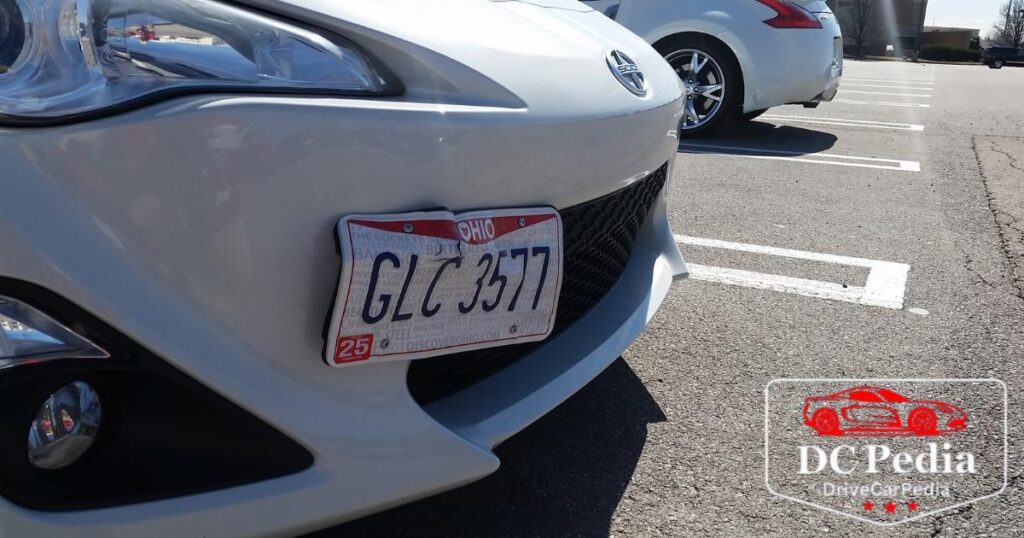Bend the corner of a license plate might seem like a quirky act, but it’s a method some drivers use to alter the visibility and readability of their vehicle’s registration number. Typically, this is done to partially obscure certain numbers or letters, potentially helping the owner avoid traffic cameras or skip out on tolls. It’s a subtle way of tampering without extensive damage to the plate itself.
Tampering with a license plate is no trivial matter. It’s considered illegal in many regions because it can interfere with law enforcement and public safety measures. Authorities use license plates to quickly identify vehicles involved in violations or more serious crimes.
By bending a plate, individuals might lower their chances of being caught in the act, but they also risk hefty fines and legal consequences if spotted.
Reasons Behind Bend the corner of a license plate
Some people bend the corners of their license plates to dodge detection by traffic cameras. This trick can hide part of the plate’s numbers or letters, making it hard for cameras at traffic lights or toll booths to read them correctly. The goal is often to avoid tickets for speeding or skipping tolls without paying.
However, this action is not just a clever workaround; it’s illegal. Bending a license plate makes it tough for police and other authorities to do their jobs, such as tracking down vehicles involved in accidents or crimes. People caught with tampered plates can face fines or other penalties, as it’s seen as an attempt to break the law.
The Symbolism of Bend the corner of a license plate
Bend the corner of a license plate might look like just a small change, but it can carry big meanings. For some, it’s a way to stand out or show that they don’t always follow the rules.
This act can symbolize a desire for freedom or a way to protest against what they see as unfair laws, especially those related to traffic enforcement or privacy. This action can also be seen in a negative light. It might suggest dishonesty or a willingness to break the law to avoid penalties like tolls or speed cameras.
To others, bending a plate might indicate a disregard for the safety and order that laws are meant to promote. So, while some see it as a minor act of rebellion, it can also be viewed as an irresponsible choice that puts others at risk.
Instances When People Bend the corner of a license plate

Sometimes people bend the corners of their license plates to avoid paying fees or fines. This can include skipping out on tolls or trying not to get caught by speed cameras. By bending a plate, the numbers or letters might be hard to read, making it tough for cameras and law enforcement to track the vehicle.
This trick can lead to serious problems. If the police notice that a license plate has been tampered with, the vehicle owner can face legal action. This might mean fines or even more severe penalties depending on the local laws. It’s a risky move that can end up costing more than just paying the original fees.
| Reason | Purpose | Potential Consequences |
| Avoiding tolls | To evade toll booth cameras | Fines, legal action |
| Evading traffic cameras | To prevent identification by speed cameras | Fines, points on license |
| Reducing parking fees | To avoid detection by parking enforcement | Fines, vehicle booting |
| Escaping law enforcement | To make the vehicle less identifiable | Increased legal penalties |
| Anonymity in hit and runs | To hinder identification in illegal activities | Legal repercussions, imprisonment |
This table gives an overview of why some individuals might bend their license plates, the purposes behind such actions, and the potential consequences they face if caught.
Exploring the Role of Bent License Plate Corners
When someone bends the corners of a license plate Frames, they’re usually trying to hide or change part of the plate’s numbers and letters. This can make it hard for cameras and police to see the full plate clearly. People might do this to avoid paying tolls or to stay unnoticed if they break traffic rules.
Bending license plate corners can lead to trouble. It’s illegal in many places because it stops police and other officials from doing their jobs, like checking if a car is stolen or involved in a crime. If caught, the driver can face fines or other penalties, making the small act of bending a plate corner a risky decision.
Understanding the Intent Behind Bending the License Plate Corners
Certainly! Bending the corners of a license plate is often a deliberate act by someone trying to avoid detection. This might be to escape traffic cameras or evade toll fees. By slightly altering the plate, they make the numbers and letters hard to read from a distance or by automated systems.
This behavior can lead to serious consequences. It is illegal in many places because it can interfere with law enforcement duties. If caught, the person can face fines or other penalties. The intent behind bending the plate corners is usually to bypass rules or avoid paying fees, but it puts the individual at risk of legal trouble.
How Bend the corner of a license plate Became a Trend
Bend the corner of a license plate became a trend as people searched for ways to avoid penalties from traffic violations. Drivers began manipulating their plates to escape speed cameras, red light cameras, and toll booth charges.
The idea spread quickly, especially among those who wanted a simple method to reduce the risk of fines without drawing too much attention to their vehicles. The trend caught on more widely through online forums and social media, where users shared tips and methods for bending license plates effectively.
This sharing of ‘how-to’ guides made it easier for others to mimic the practice. While some see it as a clever hack, law enforcement agencies and traffic authorities are increasingly aware of this tactic, leading to stricter penalties and surveillance measures to curb the practice.
Varied Reasons for Bending License Plates

Bending a license plate isn’t just about dodging tickets or tolls; there are several reasons why someone might choose to do this. Some people bend their plates to prevent theft, as a bent plate can be harder to remove quickly and quietly.
Others might do it to make their car less noticeable or identifiable in a situation where they wish to remain anonymous. In some cases, it could even be an act of rebellion or personal expression, where drivers modify their plates to make a statement. It’s important to remember that altering a license plate is illegal in many places.
This act can make it difficult for traffic cameras and law enforcement to identify a vehicle. It affects public safety by hindering the ability to track down vehicles involved in accidents or criminal activities. Despite the varied reasons for bending a plate, the consequences can include fines, penalties, and even more severe legal trouble if caught.
Is Bending License Plate Corners Against the Law?
Absolutely, Bend the corner of a license plate is generally against the law. This action can make it hard for cameras and law enforcement officers to see the plate clearly. Most places have strict rules about keeping license plates visible and intact. When someone bends a plate, it’s usually seen as trying to hide the vehicle’s identity, which can be linked to avoiding tolls or speeding tickets.
If caught with a bent license plate, a person can face various penalties. These might include fines, getting points on their driving record, or even having their vehicle registration suspended. The specific consequences depend on local laws, but the intent to deceive authorities is taken seriously.
Why do bikers flip their plates?
Bikers often flip their plates for similar reasons to why some drivers bend them. By flipping their license plates, bikers can make the numbers and letters hard to read. This trick is sometimes used to avoid speed cameras or tolls. It’s a quick way to hide their identity while on the road.
Flipping a license plate is illegal. It prevents the police from identifying a vehicle quickly. This can be a big problem, especially if the bike is involved in illegal activities or accidents. If caught, bikers can face fines or other penalties. It’s a risky move that can lead to trouble with the law.
Is A Bent License Plate Illegal
Yes, Bend the corner of a license plate is generally illegal. This act intentionally makes it hard for people to see and read the plate clearly. Laws in most places require that license plates be visible and readable from a certain distance without any obstruction. By Bend the corner of a license plate, a person can avoid being detected by traffic cameras or police, which is why it’s often against the law.
If caught with a bent license plate, the consequences can vary depending on where you are. Typically, you might face fines or even have to appear in court. Law enforcement takes this seriously because clear license plates help maintain public safety and order on the roads. It’s best to keep your license plate straight and fully visible to avoid any legal trouble.
Why Is My Front License Plate Bent

If you’ve noticed that your front license plate is bent, it could be due to a few straightforward reasons. Sometimes, it’s as simple as accidental damage; maybe the car bumped into something, or someone knocked into it while parking. Over time, regular wear and tear from driving, especially in harsh weather, can also cause the plate to bend.
Another possibility is vandalism. Occasionally, people deliberately Bend the corner of a license plate, either as a prank or with the intent to obscure the plate numbers for dodgy reasons. If you suspect this, it’s wise to check if other parts of the car are tampered with and consider reporting it to ensure your vehicle isn’t being targeted for more serious damage.
Read More: License Plate Dimensions: What You Need To Know
Bent License Plate Trafficking
Bent license plates are often linked to illicit activities, including trafficking. Criminals Bend the corner of a license plate to make it harder for law enforcement to track stolen vehicles or those used in illegal transactions. This practice helps them avoid detection while transporting illegal goods, like drugs or stolen items, across different regions.
Authorities are on the lookout for such modifications as a red flag for potential trafficking activities. Traffic cameras and patrol officers are trained to spot these irregularities. When a bent license plate is identified, it can lead to deeper investigations, potentially uncovering larger criminal operations. This makes bent license plates a significant concern in efforts to combat trafficking and maintain public safety.
- Concealment Strategy: Bend the corner of a license plate is a tactic used to obscure vehicle identification numbers, aiding criminals in avoiding detection by law enforcement.
- Link to Illegal Activities: Often associated with the trafficking of stolen goods, drugs, or even human trafficking, as obscured plates make tracking by authorities more difficult.
- Increased Scrutiny: Vehicles with bent license plates attract attention from police and traffic monitoring systems, leading to potential stops and investigations.
- Legal Penalties: Tampering with license plates is illegal and can result in fines, penalties, or more severe legal consequences.
- Detection Technology: Advanced camera systems and AI technology are increasingly used to detect and report license plates that have been altered or are unreadable.
- Public Safety Threat: Bent license plates not only hinder criminal investigations but also pose a broader threat to public safety by enabling illegal activities to go unchecked.
Car Wash Bent License Plate
Sometimes, a trip through the car wash can lead to unexpected mishaps, like a bent license plate. This often happens when the powerful brushes and equipment designed to clean the car aren’t adjusted properly or are too forceful. When the plate gets bent, it can make the numbers and letters hard to read, which isn’t just inconvenient—it could also get you in trouble with the law if it looks like Bend The Corner Of A Licenseyou’re trying to hide your vehicle’s identity.
Bent License Plate Fix
Fixing a bent license plate is usually a straightforward task that you can do at home with just a few tools. Start by removing the license plate from your vehicle using a screwdriver to unscrew the bolts. Once it’s off, place the plate on a flat surface.
You can then use a rubber mallet to gently tap out the bend, being careful not to hit too hard and damage the plate. If the license plate is severely bent or if the previous method doesn’t work, you might need to use a pair of pliers for a more precise adjustment.
Wrap the pliers’ jaws with a cloth to protect the plate’s surface, and gently bend the plate back into shape. After straightening, make sure the plate is completely flat and the numbers and letters are fully visible. Screw the plate back onto your vehicle, ensuring it’s secure and aligned properly.
Read More Post: Black California License Plate
Bent License Plate Jdm
In the world of car customization, especially within the Japanese Domestic Market (JDM) scene, Bend the corner of a license plate is sometimes seen as a stylistic choice.
Enthusiasts often modify their vehicles to stand out or to reflect a certain aesthetic, and a bent license plate can be part of this unique expression. This custom might involve slightly Bend the corner of a license plate corner or curving it around the vehicle’s bumper to match the car’s overall modified look.
How Much Does It Cost To Fix A Bent License Plate Bend the corner of a license plate
Fixing a bent corner on a license plate is usually a straightforward and inexpensive task. If the bend is minor, you might even straighten it out yourself using simple tools like pliers or a flat surface to press the plate back into shape. This DIY approach can often be done at no cost, assuming you already have the necessary tools at home.
The license plate is severely damaged or if you prefer a professional touch, a visit to a body shop might be in order. Typically, the cost at a shop would be minimal, often under $20, as this is a quick fix. But if the plate is too far gone, you might need to replace it altogether. Replacement costs vary by state and can range from $10 to $50 for a new plate.
Final Words
In a nutshell, keeping your license plate in good shape is not just about avoiding fines—it’s about staying on the right side of the law. So, whether you straighten that bend yourself or shell out a few bucks at a shop, it’s a small price to pay for peace of mind on the road. Keep it simple, keep it legal!









